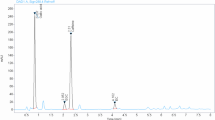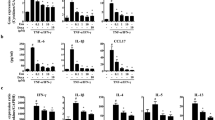Abstract
Backgrounds
Atopic dermatitis (AD) frequently affects both infants and adults, impacting on the quality of life of the individual and imposing a significant psychosocial burden. The efficacy against AD-like skin lesions of the fermented form of Korea red ginseng (FRG), that contains ginsenoside metabolites, has not been investigated.
Methods
FRG was prepared after fermentation of Korean red ginseng (KRG) extract in the presence of yeast and probiotics. The effects of FRG on skin allergic inflammation were then investigated by examining the frequency of scratching, and assessing the levels of representative allergic markers in 1-chloro-2,4-dinitrobenzene (DNCB)-challenged Balb/c mice. After two weeks of DNCB challenge, vehicle, dexamethasone (positive control), and FRG (10 and 50 μg/mL) were applied topically on skin lesions for 2 weeks. At the end of the experiment, scratching behavior, immunoglobulin E (IgE), and interleukin 4 (IL-4) levels were measured. The status of mitogen-activated protein kinases (MAPKs) and nuclear factor kappa B (NF-κB) were determined by immunoblot analysis in DNCB-treated primary splenocytes.
Results
Topical administration of FRG significantly suppressed scratching behavior, serum IgE, and IL-4 levels (P<0.05, n=5/group). In addition, FRG treatment significantly decreased the mRNA expression levels of IL-4 and IL-10 in DNCB-exposed splenocytes (P<0.05, n=6/group). Moreover, FRG suppressed DNCB-induced phosphorylation of p38 MAPK and activation of NF-κB.
Conclusion
FRG could ameliorate skin allergic inflammation via suppression of p38 MAPK and NF-κB. Therefore, FRG may be a potential therapeutic agent for the prevention and/or treatment of atopic-like dermatitis.
Similar content being viewed by others
References
Weidinger, S. & Novak, N. Atopic dermatitis. Lancet 387, 1109–1122 (2016).
Leung, D. Y. Atopic dermatitis: new insights and opportunities for therapeutic intervention. J dAllergy Clin Immunol {b105}, 860–876 (2000).
Akdis, C. A., Akdis, M., Trautmann, A. & Blaser, K. Immune regulation in atopic dermatitis. Curr Opin Immunol 12, 641–646 (2000).
Leung, D. Y. & Bieber, T. Atopic dermatitis. Lancet 361, 151–160 (2003).
Nickoloff, B. J. & Naidu, Y. Perturbation of epidermal barrier function correlates with initiation of cytokine cascade in human skin. J Am Acad Dermatol 30, 535–546 (1994).
Novak, N., Bieber, T. & Leung, D. Y. Immune mechanisms leading to atopic dermatitis. J Allergy Clin Immunol 112, S128–139 (2003).
Ellis, C. N. et al. Cost-effectiveness analysis of tacrolimus ointment versus high-potency topical corticosteroids in adults with moderate to severe atopic dermatitis. J Am Acad Dermatol 48, 553–563 (2003).
Feizy, V. & Ghobadi, A. Atopic dermatitis and systemic autoimmune diseases: a descriptive cross sectional study. Dermatol Online J 12, 3 (2006).
Homey, B., Steinhoff, M., Ruzicka, T. & Leung, D. Y. Cytokines and chemokines orchestrate atopic skin inflammation. J Allergy Clin Immunol 118, 178–189 (2006).
Lester, M. R., Hofer, M. F., Gately, M., Trumble, A. & Leung, D. Y. Down-regulating effects of IL-4 and IL-10 on the IFN-gamma response in atopic dermatitis. J Immunol 154, 6174–6181 (1995).
Moverare, R., Elfman, L., Stalenheim, G. & Bjornsson, E. Study of the Th1/Th2 balance, including IL-10 production, in cultures of peripheral blood mononuclear cells from birch-pollen-allergic patients. Allergy 55, 171–175 (2000).
Muraille, E. & Leo, O. Revisiting the Th1/Th2 paradigm. Scand J Immunol 47, 1–9 (1998).
Kawamoto, M. et al. IL-10 plays an important role as an immune-modulator in the pathogenesis of atopic diseases. Mol Med Rep 1, 837–842 (2008).
Osinka, K., Dumycz, K., Kwiek, B. & Feleszko, W. Novel therapeutic approaches to atopic dermatitis. Arch Immunol Ther Exp 66, 171–181 (2017).
Leung, D. Y. M. Atopic dermatitis: New insights and opportunities for therapeutic intervention. J Allergy Clin Immunol 105, 860–876 (2000).
Schäcke, H., Döcke, W.-D. & Asadullah, K. Mechanisms involved in the side effects of glucocorticoids. Pharmacol Ther 96, 23–43 (2002).
Lee, S. R. et al. Non-genomic effect of glucocorticoids on cardiovascular system. Pflugers Arch 464, 549–559 (2012).
Brunner, P. M. et al. The atopic dermatitis blood signature is characterized by increases in inflammatory and cardiovascular risk proteins. Scientific Reports 7, 8707 (2017).
Bae, H. M. et al. Antioxidant activities of ginseng seeds treated by autoclaving. J Ginseng Res 36, 411–417 (2012).
Keum, Y. S. et al. Antioxidant and anti-tumor promoting activities of the methanol extract of heat-processed ginseng. Cancer Lett 150, 41–48 (2000).
Jung, J. H., Kang, I. G., Kim, D. Y., Hwang, Y. J. & Kim, S. T. The effect of Korean red ginseng on allergic inflammation in a murine model of allergic rhinitis. J Ginseng Res 37, 167–175 (2013).
Kimura, Y., Sumiyoshi, M. & Sakanaka, M. Effects of ginsenoside Rb (1) on skin changes. J Biomed Biotechnol 2012, 946242 (2012).
Samukawa, K. et al. Red ginseng inhibits scratching behavior associated with atopic dermatitis in experimental animal models. J Pharmacol Sci 118, 391–400 (2012).
Tachikawa, E. et al. Effects of ginseng saponins on responses induced by various receptor stimuli. Eur J Pharmacol 369, 23–32 (1999).
Izuhara, K., Yanagihara, Y., Hamasaki, N., Shirakawa, T. & Hopkin, J. M. Atopy and the human IL-4 receptor alpha chain. J Allergy Clin Immunol 106, S65–71 (2000).
Yun, J.-W., Kim, H., Kang, H.-J., Koh, J.-Y. & Kim, B.-H. Comparative evaluation of animal models for atopic dermatitis in NC/Nga mice. Lab Anim Res 24, 59–66 (2008).
Sohn, E. H. et al. Effects of Korean red ginseng extract for the treatment of atopic dermatitis-like skin lesions in mice. J Ginseng Res 35, 479–486 (2011).
Amidon, G. L., Lennernas, H., Shah, V. P. & Crison, J. R. A theoretical basis for a biopharmaceutic drug classification: the correlation of in vitro drug product dissolution and in vivo bioavailability. Pharm Res 12, 413–420 (1995).
Tawab, M. A., Bahr, U., Karas, M., Wurglics, M. & Schubert-Zsilavecz, M. Degradation of ginsenosides in humans after oral administration. Drug Metab Dispos 31, 1065–1071 (2003).
Tanaka, T., Matsuo, Y. & Kouno, I. Chemistry of secondary polyphenols produced during processing of tea and selected foods. Int J Mol Sci 11, 14–40 (2009).
Bae, S. H. et al. Changes of ginsenoside content by mushroom mycelial fermentation in red ginseng extract. J Ginseng Res 35, 235–242 (2011).
Jang, S.-A. et al. Gamma irradiation-induced liver injury and its amelioration by red ginseng extract. Mol Cell Toxicol 13, 461–469 (2017).
Park, H.-J. et al. The comparative study of anti-allergic and anti-inflammatory effects by fermented red ginseng and red ginseng. Korean J Plant Res 23, 415–422 (2010).
Lim, J. D. et al. Fucoidan from Fucus vesiculosus protects against alcohol-induced liver damage by modulating inflammatory mediators in mice and HepG2 cells. Mar Drugs 13, 1051–1067 (2015).
Koo, H. J. et al. Effects of red ginseng on the regulation of cyclooxygenase-2 of spleen cells in whole-body gamma irradiated mice. Food Chem Toxicol 62, 839–846 (2013).
Overbergh, L., Valckx, D., Waer, M. & Mathieu, C. Quantification of murine cytokine mRNAs using real time quantitative reverse transcriptase PCR. Cytokine 11, 305–312 (1999).
Yang, L. et al. Essential role of nuclear factor kappaB in the induction of eosinophilia in allergic airway inflammation. J Exp Med 188, 1739–1750 (1998).
Hai, C. M. Mechanistic systems biology of inflammatory gene expression in airway smooth muscle as tool for asthma drug development. Curr Drug Discov Technol 5, 279–288 (2008).
Roux, P. P. & Blenis, J. ERK and p38 MAPK-activated protein kinases: a family of protein kinases with diverse biological functions. Microbiol Mol Biol Rev 68, 320–344 (2004).
Nam, K.-Y. The comparative understanding between red ginseng and white ginsengs, processed ginsengs (Panax ginseng C. A. Meyer). J Ginseng Res 29, 1–18 (2005).
Lee, H.-S. et al. Fermenting red ginseng enhances its safety and efficacy as a novel skin care anti-aging ingredient: in vitro and animal study. J Med Food 15, 1015–1023 (2012).
Park, E. K., Choo, M. K., Kim, E. J., Han, M. J. & Kim, D. H. Antiallergic activity of ginsenoside Rh2. Biol Pharm Bull 26, 1581–1584 (2003).
Peti, W. & Page, R. Molecular basis of MAP kinase regulation. Protein Sci 22, 1698–1710 (2013).
Ipaktchi, K. et al. Topical p38MAPK inhibition reduces dermal inflammation and epithelial apoptosis in burn wounds. Shock 26, 201–209 (2006).
Hengge, U. R., Ruzicka, T., Schwartz, R. A. & Cork, M. J. Adverse effects of topical glucocorticosteroids. J Am Acad Dermatol 54, 1–15; quiz 16-18 (2006).
Author information
Authors and Affiliations
Corresponding author
Rights and permissions
About this article
Cite this article
Kang, S.C., Lee, S.R., Hadiwidjaja, M. et al. Mitigating effect of fermented Korean red ginseng extract with yeast and probiotics in 1-chloro-2,4-dinitrobenzene-induced skin allergic inflammation. Mol. Cell. Toxicol. 15, 111–121 (2019). https://doi.org/10.1007/s13273-019-0014-z
Received:
Accepted:
Published:
Issue Date:
DOI: https://doi.org/10.1007/s13273-019-0014-z




